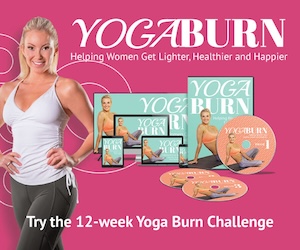Vinyasa Flow Yoga:
Vinyasa is a Sanskrit term which has multiple meanings. Its literal translation “positioning in a special way”. Think of it as a way of moving the body that is, purposeful. Vinyasa yoga (Vinyasa Flow Yoga) also pays close attention to breath.
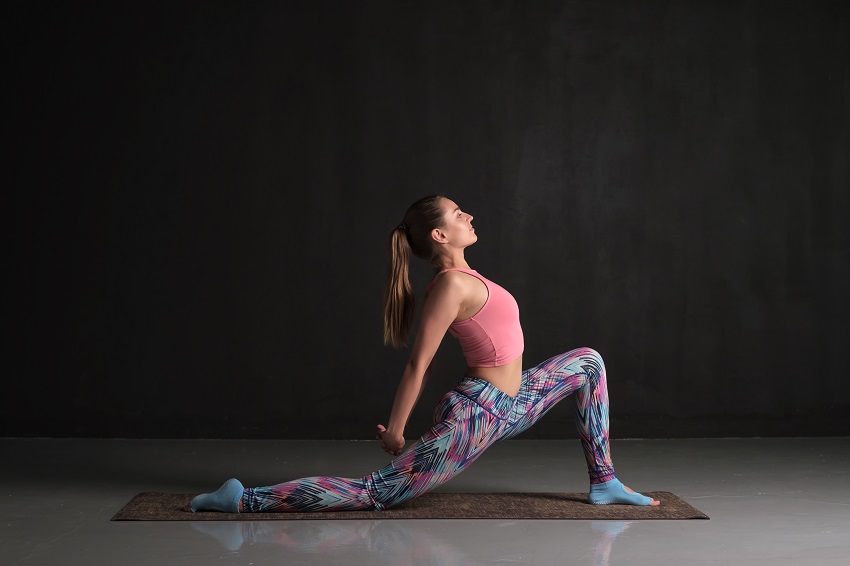
Vinyasa Yoga: An Overview
Definition and Variants:
- Vinyasa yoga, commonly known as Flow Yoga, is a dynamic form of yoga that emphasizes the smooth transition between postures, synchronized with breath.
- It encompasses various styles, including:
- Ashtanga Yoga
- Baptiste Yoga
- Power Yoga
Key Elements:
- The practice involves a sequence of movements coordinated with inhalation and exhalation.
- Unlike static yoga styles, Vinyasa links poses in a flowing sequence.
Vinyasa as a Style:
- In addition to being a component of flow yoga, Vinyasa itself is recognized as a distinct style.
- It focuses on dynamic transitions that connect asanas in a fluid manner.
- Precision in movements is crucial, with attention to opening and closing each posture effectively.
Table: Characteristics of Vinyasa Yoga
| Feature | Description |
|---|---|
| Breath Coordination | Movements are synchronized with breath, enhancing flow and rhythm. |
| Variety in Sequences | No fixed sequence; instructors often create unique flows. |
| Emphasis on Transition | Focus on smooth transitions between asanas. |
| Dynamic Nature | More active and engaging compared to static yoga forms. |
| Instructor’s Creativity | Each class can offer different themes or focus areas (e.g., strength, flexibility). |
| Pacing | The flow can be fast-paced for intensity or slower for deeper stretches. |
Popularity of Vinyasa Yoga:
- Variety and Flexibility: One of the primary reasons for Vinyasa yoga’s popularity is its variability. Instructors have the freedom to design sequences, offering a unique experience in every class.
- Adaptability: Classes can focus on different themes, such as backbends or specific strength and flexibility goals.
- Progressive Learning: Instructors may build upon previous classes, enhancing the challenge and diversity over time.
- Engaging Classes: The ever-changing nature of sequences keeps the practice exciting and unpredictable for regular practitioners.
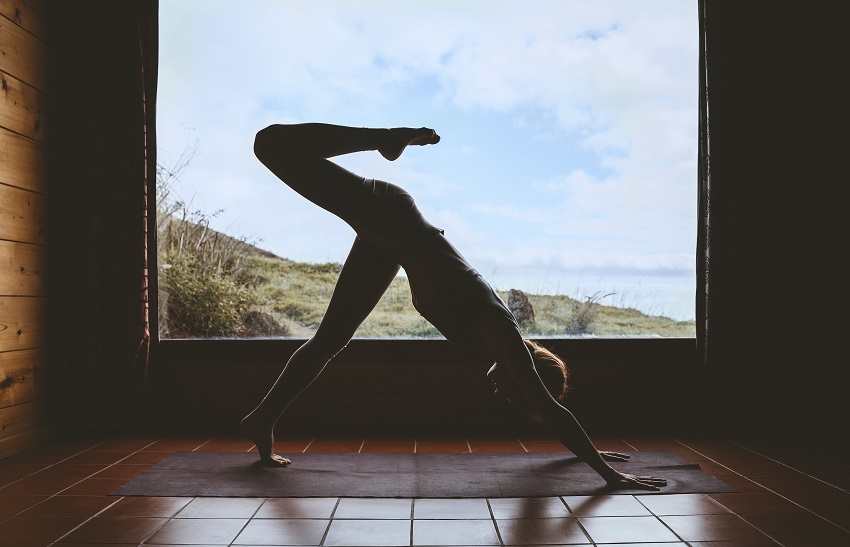
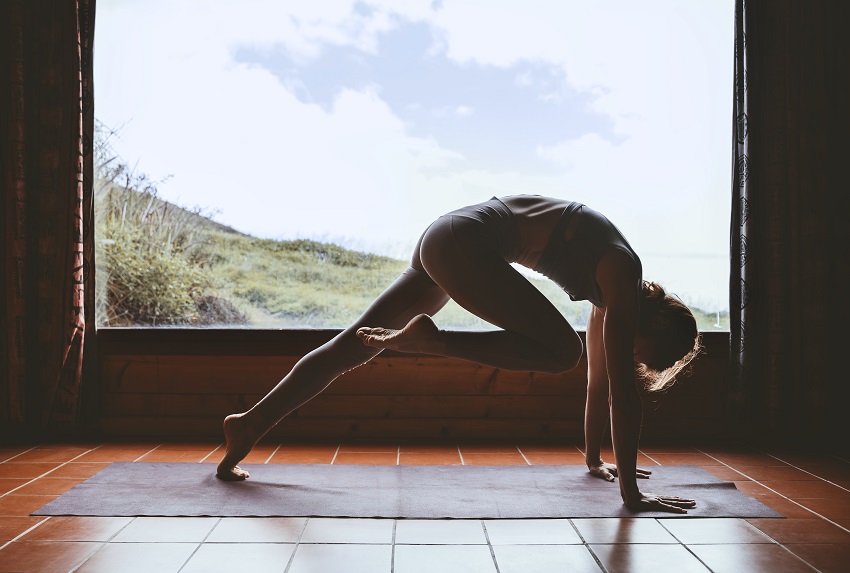
There is something for everyone. Vinyasa yoga can be tailored to the most beginner yogi, all the way to the most experienced. Meaning the classes can be modified to meet your specific goals in mind.
Physical Benefits of Vinyasa Yoga
Vinyasa yoga offers a wide range of benefits that vary depending on the specific class and sequence. Here, we’ll explore some of the general advantages of this dynamic practice.
Strength and Flexibility:
- The energetic flow of Vinyasa yoga incorporates movements that build strength, flexibility, and agility.
- It engages not just the major muscle groups but also the smaller stabilizing muscles often overlooked in traditional weight training.
- Regular practice leads to enhanced core strength, owing to the continuous engagement required in various poses, including balances, twists, and bends.
Cardiovascular Health:
- Vinyasa yoga can be as beneficial for cardiovascular health as running. Sequences like Sun Salutations elevate the heart rate into the endurance zone.
- Unlike slower yoga styles such as Hatha or Restorative, Vinyasa maintains an elevated heart rate throughout the session due to its flowing nature.
Related Article: Yoga for Heart Health: Vital Poses to Practice

Mental and Psychological Benefits:
Balance and Coordination:
- The focus on synchronized breathing improves balance and coordination, especially during twisting and bending poses.
Stress Reduction:
- Vinyasa yoga is not just a physical workout; it also offers psychological benefits.
- The practice is known for reducing stress, anxiety, and depression, making it beneficial for diverse groups, from busy professionals to college students.
- The relaxation and inner calm promoted by Vinyasa yoga can also aid in alleviating sleep disorders like insomnia.
In summary, Vinyasa yoga is a holistic practice that positively impacts both the body and mind, offering a comprehensive approach to well-being.
Vinyasa Yoga Poses: Detailed Guide
Vinyasa Yoga is known for its diverse range of poses, often tailored to the theme of the class. These themes can vary, focusing on aspects like backbends, forward bends, or strength improvement. Below is a common pose you might encounter in a Vinyasa class, with detailed step-by-step instructions. Then, we move to a simple sequence.
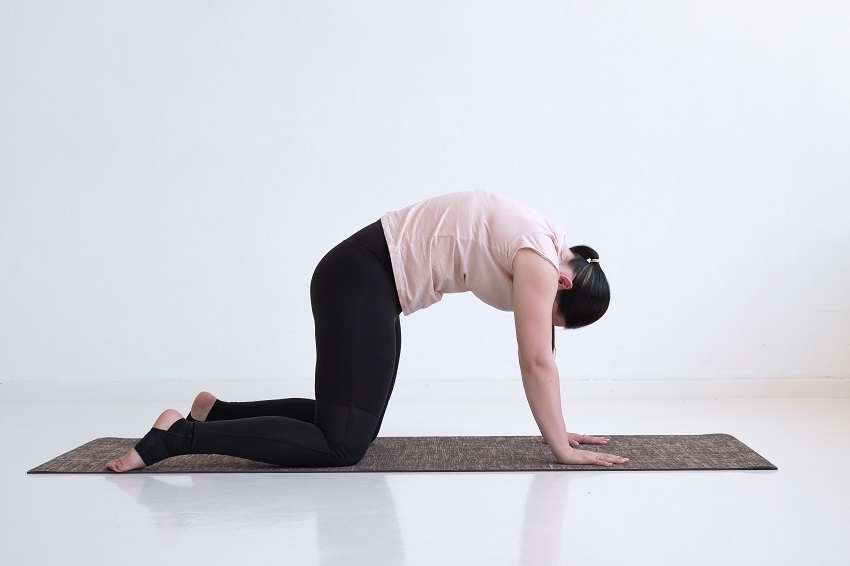
Table: Step-by-Step Guide to Vinyasa Yoga Poses
| Pose Name (Sanskrit) | Step-by-Step Instructions |
|---|---|
| Cat Pose (Marjariasana) | 1. Begin by positioning yourself on all fours, ensuring your knees are directly below your hips and your wrists, elbows, and shoulders are in line and perpendicular to the floor. 2. Center your head in a neutral position, eyes looking at the floor. 3. As you exhale, round your spine toward the ceiling, making sure to keep your shoulders and knees in position. 4. Release your head toward the floor, but don’t force your chin to your chest. 5. Inhale, coming back to the neutral “tabletop” position on your hands and knees. |
| Cow Pose (Bitilasana) | 1. Start in the same tabletop position as for the Cat Pose. 2. As you inhale, lift your sitting bones and chest toward the ceiling, allowing your belly to sink toward the floor. 3. Lift your head to look straight forward. 4. Exhale, coming back to the neutral tabletop position. 5. This pose is often paired with the Cat Pose, so you can flow smoothly between the two, inhaling as you move into Cow Pose and exhaling into Cat Pose. |
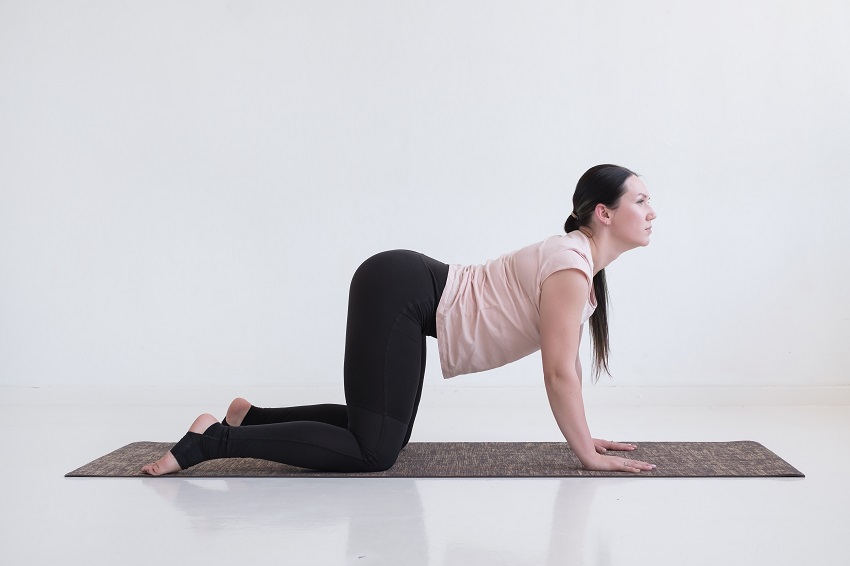
This pose is typically integrated into the flow of a Vinyasa class, excellent for warming up the spine and are often used to teach beginners how to synchronize their movements with their breath, a key aspect of Vinyasa yoga. Each movement in and out of these poses should be performed with a breath cycle, ensuring a harmonious flow of movement and breath.
Vinyasa Flow Yoga Sequence:
The sequential execution of the postures is another distinctive feature of flow yoga. Here the union of the asanas with each other is fundamental, thanks to transitional movements.
Let’s highlight 3 of these movements:
Downward Facing Dog (Adho Mukha Svanasana):
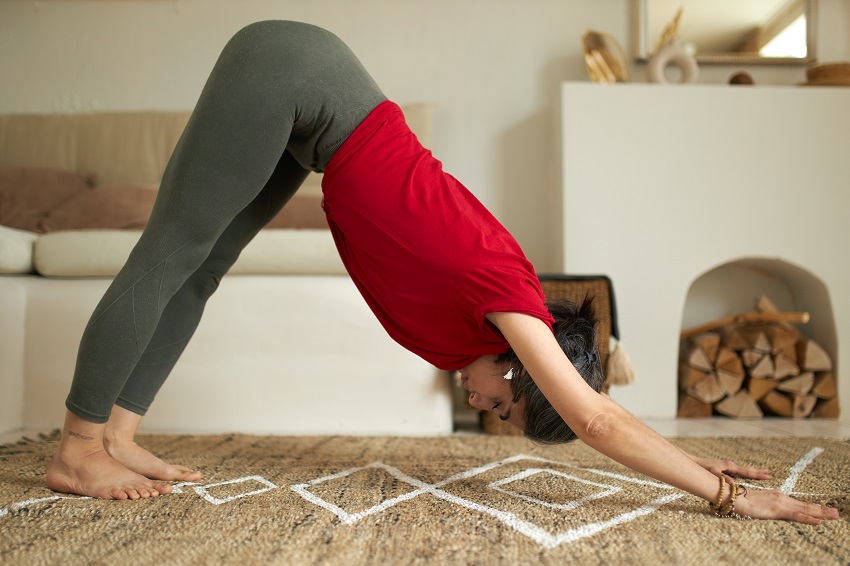
Remember in class, you’ll be creating a flow through these poses.
| Step | Instruction |
|---|---|
| 1 | Begin in an all-fours position, ensuring your hands are directly under your shoulders and knees under your hips. |
| 2 | Transition into the pose by lifting your hips and buttocks upward, forming an inverted “V” shape with your body. |
| 3 | Press firmly through your palms and feet. Extend your pelvis upwards while trying to straighten your legs. |
| 4 | Aim to keep your back heels pressed down towards the ground, though it’s okay if they don’t fully touch. |
| 5 | Maintain controlled breathing throughout the pose. Inhale and exhale deeply and steadily. |
| 6 | Stretch down through your arms and elongate your torso, ensuring your head is in line with your arms, not hanging down. |
This pose, Downward Dog, is a foundational posture in many yoga practices, including Vinyasa Yoga. It helps to strengthen and stretch the entire body and is often used as a transitional pose or a resting pose within a sequence. Remember, the focus is on the process and the alignment, not just the final pose.
Low Plank, Four Limbed Staff Pose (Chaturanga Davanasana):
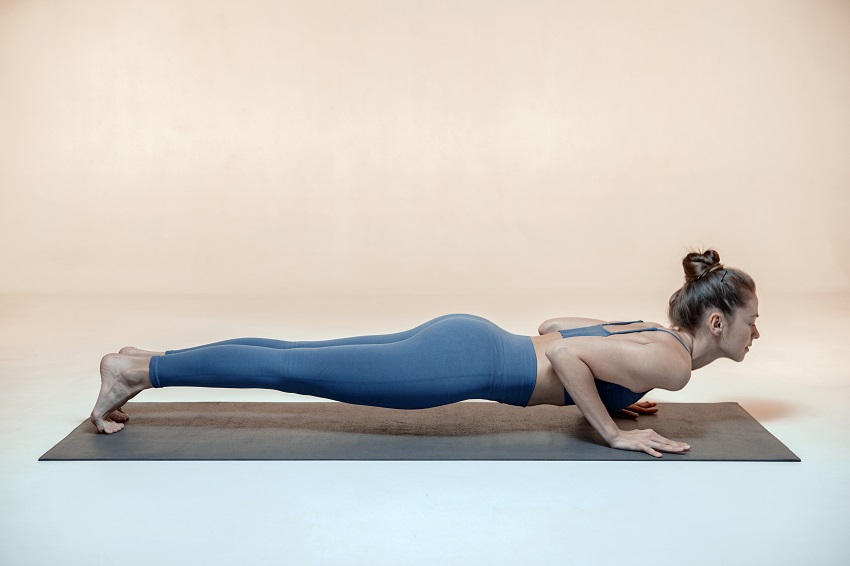
| Step | Instruction |
|---|---|
| 1 | Start from the Downward Dog pose (Adho Mukha Svanasana). Ensure your body forms a stable inverted “V” shape. |
| 2 | Inhale and shift your torso forward so that your shoulders are directly over your wrists, maintaining a straight line with your body. |
| 3 | Exhale slowly as you bend your elbows, keeping them close to your body. |
| 4 | Lower your body in a controlled manner until your chest and elbows are at the same height, parallel to the floor. |
| 5 | Keep your back straight and core engaged to avoid sagging your hips or arching your back excessively. |
| 6 | Hold this position for a few moments, continuing to breathe steadily and deeply. |
Low Plank Pose, or Chaturanga Dandasana, is a key component in the Vinyasa flow and is pivotal for building strength and endurance. This pose is challenging as it requires considerable upper body and core strength. It’s important to perform this transition smoothly and with control, focusing on maintaining correct alignment and breath synchronization.
Upward Facing Dog (Urdhva Mukha Svanasana):
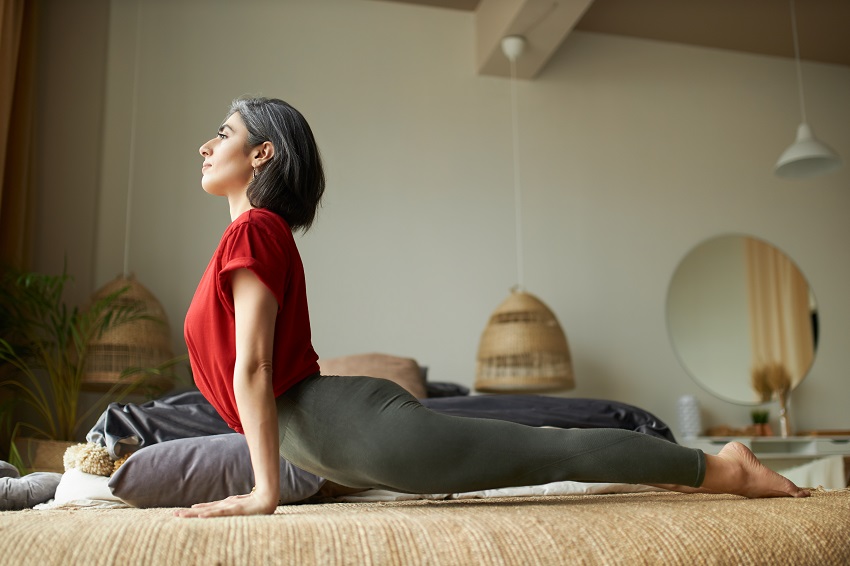
| Step | Instruction |
|---|---|
| 1 | Begin from Low Plank Pose (Chaturanga Dandasana) with your abdomen close to the mat. |
| 2 | Position your legs hip-width apart, resting the tops of your feet flat on the mat, with toes extended straight back. |
| 3 | Place your hands firmly below your shoulders, keeping your elbows close to your sides. |
| 4 | Inhale and slowly lift your chest and pelvis off the mat by straightening your arms. |
| 5 | Ensure your shoulders are drawn back and down, away from your ears, to keep them open and straight. |
| 6 | Use the strength in your hands and arms to press upward, extending through the spine and opening the chest. |
| 7 | Keep your legs and hips slightly raised off the mat, engaging your thighs and core for support. |
In the Upward Facing Dog Pose, or Urdhva Mukha Svanasana, it’s important to maintain a smooth transition from the preceding pose, ensuring fluidity and control. This pose is beneficial for stretching the chest, shoulders, and abdomen while strengthening the spine, arms, and wrists. Remember to keep the movement controlled and aligned with your breath for the best results.
Final Thoughts!
Our exploration of Vinyasa yoga began with the grounding and centering Downward Dog Pose (Adho Mukha Svanasana), transitioned into the strength-building Low Plank Pose (Chaturanga Dandasana), and then gracefully ascended into the heart-opening Upward Facing Dog Pose (Urdhva Mukha Svanasana), before returning to the stabilizing embrace of Downward Dog.
This flow is just a glimpse into the dynamic and enriching world of Vinyasa yoga. As you continue on this path, you’ll discover the power of synchronizing breath with movement, deepening your mind-body connection, and exploring the balance and harmony within each pose. Vinyasa yoga offers a unique journey of self-discovery and transformation, where each practice brings new insights and progress.
To further understand the distinct aspects of Vinyasa yoga, here’s a compare and contrast chart highlighting its features against other yoga styles:
Vinyasa Yoga vs. Other Yoga Styles
| Feature | Vinyasa Yoga | Other Yoga Styles |
|---|---|---|
| Flow | Emphasizes seamless transitions between poses, creating a fluid movement throughout the practice. | May have more static poses with longer holds, focusing on individual posture alignment. |
| Breath Synchronization | Integral part of the practice, with each movement tied to an inhale or exhale. | Breathing techniques might be taught separately from physical postures. |
| Pacing | Often faster-paced, suitable for a dynamic and invigorating practice. | Can vary from slow and gentle to moderate, depending on the style. |
| Sequence Variation | No fixed sequences; allows for creative and varied classes each time. | Some styles, like Ashtanga, follow a specific, unchanging sequence. |
| Focus | Balances strength, flexibility, and endurance with a holistic approach. | Might emphasize specific aspects, like relaxation in Restorative yoga or alignment in Iyengar yoga. |
This chart highlights the unique aspects of Vinyasa yoga compared to other styles, helping you appreciate the diverse experiences each form of yoga offers. As you continue your practice, embrace these differences and explore how they resonate with your personal yoga journey.
References:
- https://www.yogajournal.com/yoga-101/types-of-yoga/vinyasa-yoga/#:~:text=Ashtanga%2C%20Baptiste%20Yoga%2C%20Jivamukti%2C,throughout%20a%20vinyasa%20class%E2%80%8B.
- https://pubmed.ncbi.nlm.nih.gov/27250211/
- https://www.ncbi.nlm.nih.gov/pmc/articles/PMC4728955/
- https://faseb.onlinelibrary.wiley.com/doi/abs/10.1096/fasebj.31.1_supplement.lb742
- https://www.nike.com/a/yoga-cardio-strength-training
- https://www.ncbi.nlm.nih.gov/pmc/articles/PMC3193654/
- https://pubmed.ncbi.nlm.nih.gov/25858652/
- https://pubmed.ncbi.nlm.nih.gov/29166771/

